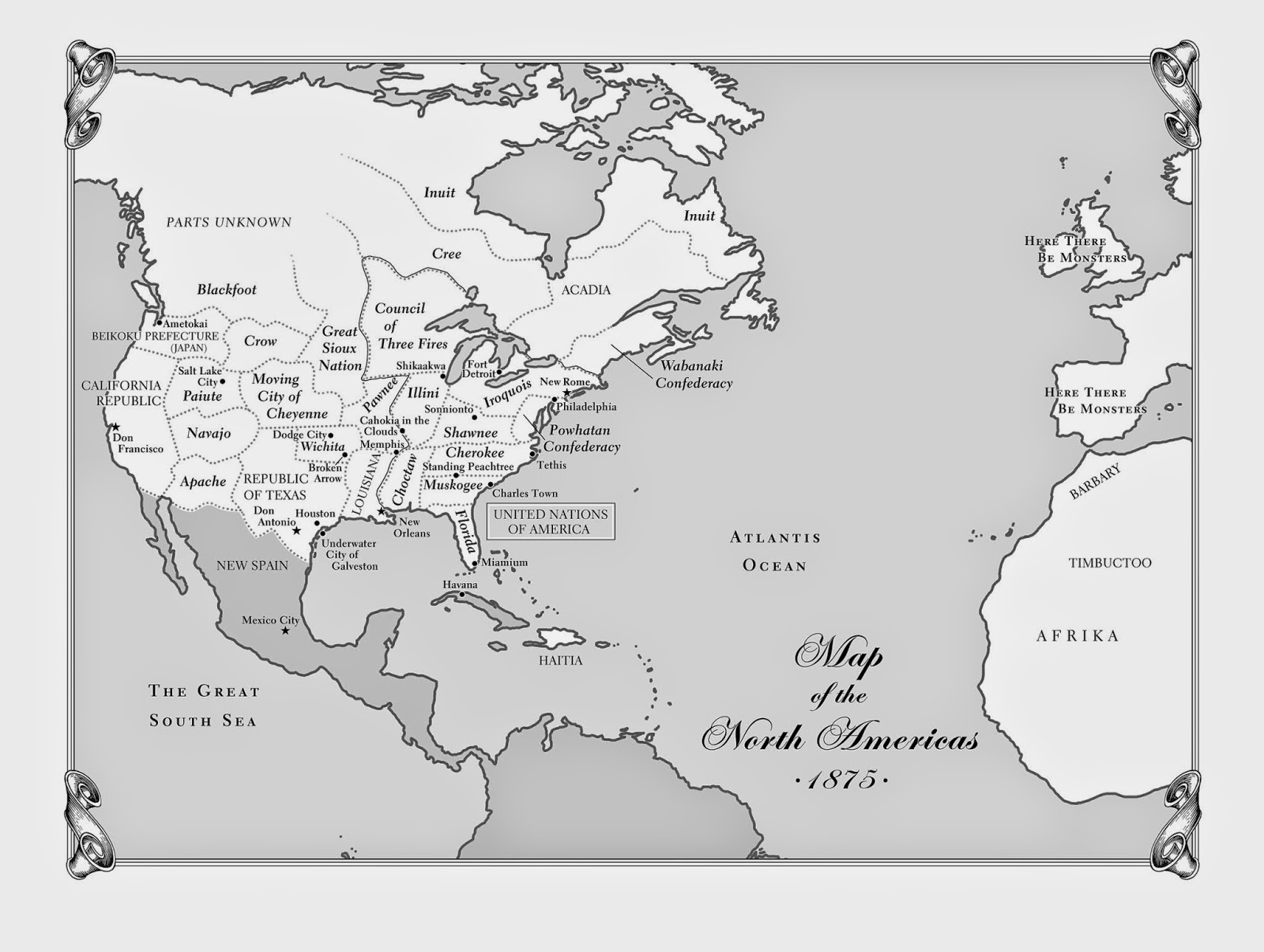Editor's Note
Moving can be stressful, but it also can be rewarding. There are two positives about packing for a move that people don't think about. First, you discover just how much junk you really have and how cathartic it feels to finally throw it away. Second, you rediscover things you thought you lost and thus can treasure them all over again.
History is a lot like that. By studying it you realize just how much junk our shared record contains and why some of it needs to be thrown away. Sort of like books that are infected by bias or nationalism. That being said, by studying history we also discover tidbits that we have forgotten about, which opens up a whole new path of study.
More importantly, you don't need to pay movers to do any of the above. Every individual has the power to immerse themselves fully into history without anyone's help.
And now the news...
Paradox Interactive Reveals Fantastical Lineup for Gamescom 2014
Paradox Interactive announced the catalog of games that would be on display – and playable by attendees – at the Gamescom trade show in Cologne, Germany on August 13-17, 2014. Among many of the games announced, Paradox will be publicly showcasing Hearts of Iron IV, the highly anticipated World War II strategy war-game, for the first time ever in a live demonstration during Fan Gathering 2014, an annual event where Paradox Development Studio fans and devs alike can commingle and plot world domination together. Fan Gathering 2014 will take place in Cologne on August 14, 2014.
Fan Gathering 2014 will also play host to a guest panel of Paradox personnel, including CEO Fred Wester and Paradox Development Studio veteran Johan Andersson, which will be moderated by popular YouTuber Quill18. Hear banter on developing strategy games, ask Fred embarrassing questions about his love of karaoke, or just stare intently into Johan’s deep blue eyes.
Let us know at The Update how Hearts of Iron IV was if you happen to be attending Gamescom.
Links to the Multiverse
Books
5 Things You Didn't Know About Steampunk by Paul Di Filippo at Huff Post.
10 Science Fiction Novels You Pretend to Have Read (And Why You Should Actually Read Them) by Charlie Jane Anders at io9.
D.B. Jackson on The History Behind The Historical Fiction Behind the THIEFTAKER CHRONICLES at SF Signal.
Review: Alfred and Emily by Doris Lessing at mirabile dictu.
Reviews: The Chronicles of Light and Shadow 2 and 3: A Clockwork Heart, Sky Pirates by Liesel Schwarz at Falcata Times.
Reviews: The Enceladus Crisis and The Gravity of the Affair by Michael J. Martinez at The Qwillery.
Review: The Man in the High Castle by Philip K Dick at mirabile dictu.
Review: The Return of the Discontinued Man by Mark Hodder at Thinking about books.
Review: The Windsor Faction by DJ Taylor at mirabile dictu.
The Story Behind Alessandro Tarabotti's Cover Art by Gail Carriger.
Writing a Truly Dastardly Villain by Cindy Spencer Pape at Steamed.
Counterfactual and Traditional History (Plus News)
46 days to Cougar football: Alternate history, what if Toni Pole scored in the Apple Cup? by Mark Sandritter at SB Nation.
Birth control saves money. Lots of it. by Ezra Klein at Vox.
The Remarkable Predictions And Inventions Of Sir Winston Churchill by George Dvorsky at io9.
Sears, Walmart Pull Poster of Nazis' Dachau Camp by Susanna Kim at ABC News.
Steven Spielberg Triceratops ‘Trophy Shot’ Causes Backlash Against Director On Facebook by Treye Green at International Business Times.
Film and Television
'In the Event of a Moon Disaster' Offers Alternate History of Apollo 11 by Jennifer Lafferty at Stack Gamer.
Read Them Now, Watch Them Later: Science Fiction, Fantasy and Horror Adaptation Watch—The Stephen King Edition by John DeNardo at Kirkus.
Games
Insomnia RPG Playable Tech Demo Now Available by Julian Horsey at Geeky Gadgets.
Interviews
Ian Doescher at Geekadelphia.
Lavie Tidhar at SF Signal.
Jo Walton at Lightspeed.
Podcasts
Dissecting Worlds Series 8, Episode 7: Religion Feedback at Geek Syndicate.
Dissecting Worlds: Series 9 Running Order at Geek Syndicate.
Moving can be stressful, but it also can be rewarding. There are two positives about packing for a move that people don't think about. First, you discover just how much junk you really have and how cathartic it feels to finally throw it away. Second, you rediscover things you thought you lost and thus can treasure them all over again.
History is a lot like that. By studying it you realize just how much junk our shared record contains and why some of it needs to be thrown away. Sort of like books that are infected by bias or nationalism. That being said, by studying history we also discover tidbits that we have forgotten about, which opens up a whole new path of study.
More importantly, you don't need to pay movers to do any of the above. Every individual has the power to immerse themselves fully into history without anyone's help.
And now the news...
Paradox Interactive Reveals Fantastical Lineup for Gamescom 2014
Paradox Interactive announced the catalog of games that would be on display – and playable by attendees – at the Gamescom trade show in Cologne, Germany on August 13-17, 2014. Among many of the games announced, Paradox will be publicly showcasing Hearts of Iron IV, the highly anticipated World War II strategy war-game, for the first time ever in a live demonstration during Fan Gathering 2014, an annual event where Paradox Development Studio fans and devs alike can commingle and plot world domination together. Fan Gathering 2014 will take place in Cologne on August 14, 2014.
Fan Gathering 2014 will also play host to a guest panel of Paradox personnel, including CEO Fred Wester and Paradox Development Studio veteran Johan Andersson, which will be moderated by popular YouTuber Quill18. Hear banter on developing strategy games, ask Fred embarrassing questions about his love of karaoke, or just stare intently into Johan’s deep blue eyes.
Let us know at The Update how Hearts of Iron IV was if you happen to be attending Gamescom.
Books
5 Things You Didn't Know About Steampunk by Paul Di Filippo at Huff Post.
10 Science Fiction Novels You Pretend to Have Read (And Why You Should Actually Read Them) by Charlie Jane Anders at io9.
D.B. Jackson on The History Behind The Historical Fiction Behind the THIEFTAKER CHRONICLES at SF Signal.
Review: Alfred and Emily by Doris Lessing at mirabile dictu.
Reviews: The Chronicles of Light and Shadow 2 and 3: A Clockwork Heart, Sky Pirates by Liesel Schwarz at Falcata Times.
Reviews: The Enceladus Crisis and The Gravity of the Affair by Michael J. Martinez at The Qwillery.
Review: The Man in the High Castle by Philip K Dick at mirabile dictu.
Review: The Return of the Discontinued Man by Mark Hodder at Thinking about books.
Review: The Windsor Faction by DJ Taylor at mirabile dictu.
The Story Behind Alessandro Tarabotti's Cover Art by Gail Carriger.
Writing a Truly Dastardly Villain by Cindy Spencer Pape at Steamed.
Counterfactual and Traditional History (Plus News)
46 days to Cougar football: Alternate history, what if Toni Pole scored in the Apple Cup? by Mark Sandritter at SB Nation.
Birth control saves money. Lots of it. by Ezra Klein at Vox.
The Remarkable Predictions And Inventions Of Sir Winston Churchill by George Dvorsky at io9.
Sears, Walmart Pull Poster of Nazis' Dachau Camp by Susanna Kim at ABC News.
Steven Spielberg Triceratops ‘Trophy Shot’ Causes Backlash Against Director On Facebook by Treye Green at International Business Times.
Film and Television
'In the Event of a Moon Disaster' Offers Alternate History of Apollo 11 by Jennifer Lafferty at Stack Gamer.
Read Them Now, Watch Them Later: Science Fiction, Fantasy and Horror Adaptation Watch—The Stephen King Edition by John DeNardo at Kirkus.
Games
Insomnia RPG Playable Tech Demo Now Available by Julian Horsey at Geeky Gadgets.
Interviews
Ian Doescher at Geekadelphia.
Lavie Tidhar at SF Signal.
Jo Walton at Lightspeed.
Podcasts
Dissecting Worlds Series 8, Episode 7: Religion Feedback at Geek Syndicate.
Dissecting Worlds: Series 9 Running Order at Geek Syndicate.
* * *
Matt Mitrovich is the founder and editor of Alternate History Weekly Update and a blogger on Amazing Stories. Check out his short fiction. When not writing he works as an attorney, enjoys life with his beautiful wife Alana and prepares for the inevitable zombie apocalypse. You can follow him on Facebook or Twitter.































